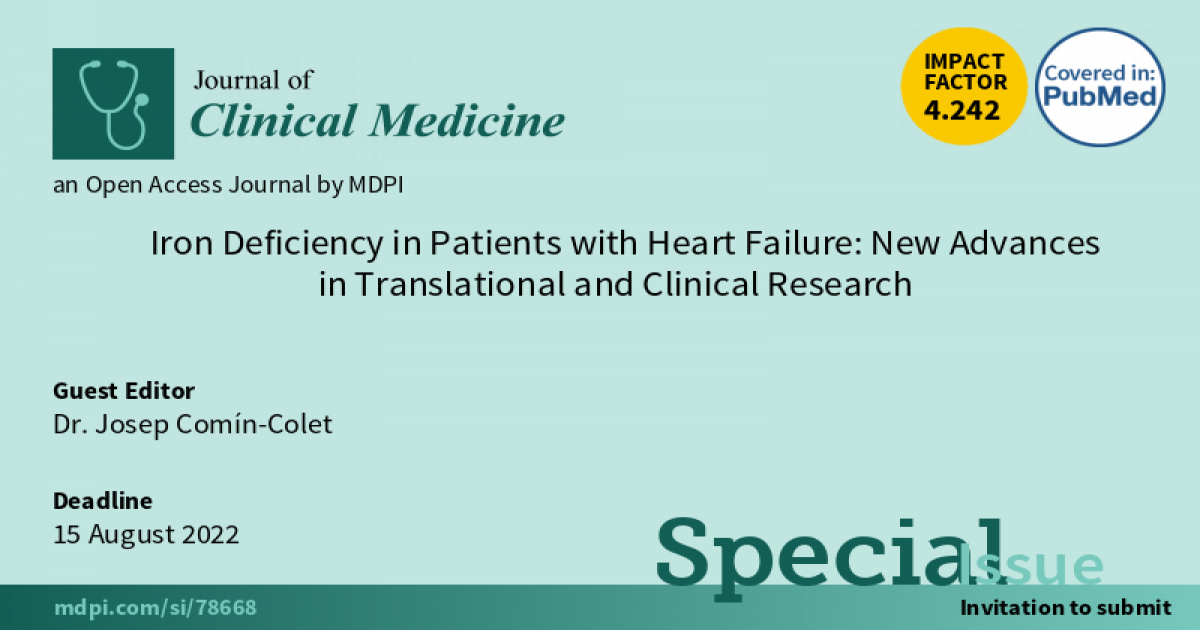- 2.9Impact Factor
- 5.2CiteScore
- 18 daysTime to First Decision
Iron Deficiency in Patients with Heart Failure: New Advances in Translational and Clinical Research
This special issue belongs to the section “Cardiology“.
Special Issue Information
Dear Colleagues,
Heart failure is a devastating syndrome with a very negative impact on mortality, morbidity, and health-related quality of life in patients with this diagnosis. Heart failure also represents a challenge to healthcare systems due to its growing prevalence and the rising medical resource use and expenditure associated with this syndrome. Comorbidities, and particularly iron deficiency, have been identified as a factor that may partially explain the occurrence of major adverse events and limitations in patient-reported outcomes in the setting of heart failure. Recent advances in research have settled the basis of the treatment of iron deficiency and helped to understand the pathophysiological pathways linking iron deficiency and heart failure. However, there are still many gaps of knowledge regarding the complex interplay between iron deficiency and heart failure. In summary, new advances in translational and clinical research will broaden the knowledge of iron deficiency in heart failure and will increase awareness of clinicians about this comorbidity. All these will finally translate into benefits for heart failure patients.
Dr. Josep Comín-Colet
Guest Editor
Manuscript Submission Information
Manuscripts should be submitted online at www.mdpi.com by registering and logging in to this website. Once you are registered, click here to go to the submission form. Manuscripts can be submitted until the deadline. All submissions that pass pre-check are peer-reviewed. Accepted papers will be published continuously in the journal (as soon as accepted) and will be listed together on the special issue website. Research articles, review articles as well as short communications are invited. For planned papers, a title and short abstract (about 250 words) can be sent to the Editorial Office for assessment.
Submitted manuscripts should not have been published previously, nor be under consideration for publication elsewhere (except conference proceedings papers). All manuscripts are thoroughly refereed through a single-blind peer-review process. A guide for authors and other relevant information for submission of manuscripts is available on the Instructions for Authors page. Journal of Clinical Medicine is an international peer-reviewed open access semimonthly journal published by MDPI.
Please visit the Instructions for Authors page before submitting a manuscript. The Article Processing Charge (APC) for publication in this open access journal is 2600 CHF (Swiss Francs). Submitted papers should be well formatted and use good English. Authors may use MDPI's English editing service prior to publication or during author revisions.
Keywords
- Iron deficiency
- iron metabolism
- heart failure
- comorbidities
- translational medicine
- outcomes research
- anemia

Benefits of Publishing in a Special Issue
- Ease of navigation: Grouping papers by topic helps scholars navigate broad scope journals more efficiently.
- Greater discoverability: Special Issues support the reach and impact of scientific research. Articles in Special Issues are more discoverable and cited more frequently.
- Expansion of research network: Special Issues facilitate connections among authors, fostering scientific collaborations.
- External promotion: Articles in Special Issues are often promoted through the journal's social media, increasing their visibility.
- e-Book format: Special Issues with more than 10 articles can be published as dedicated e-books, ensuring wide and rapid dissemination.

